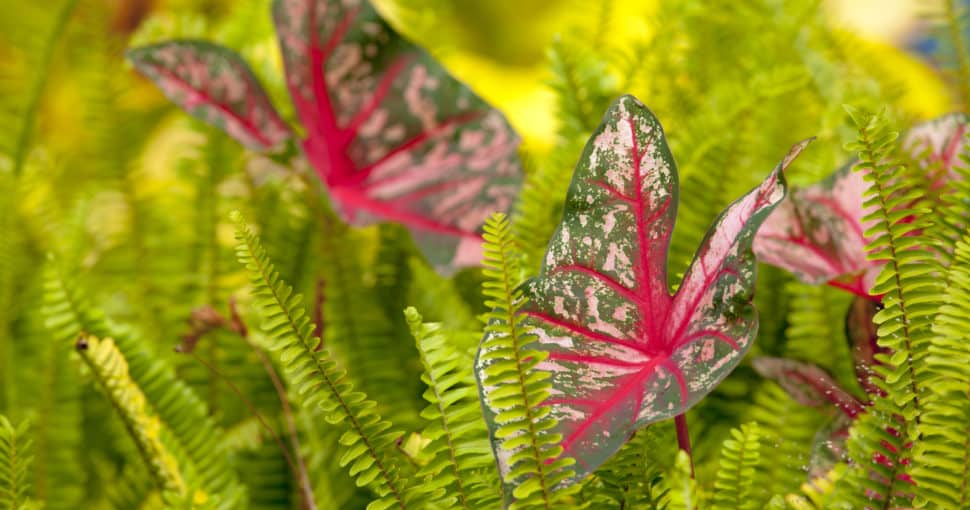North Carolina is home to hundreds of different species of poisonous plants. While some of these plants are more common than others, all of them can be dangerous to unsuspecting livestock, pets, kids, and adults. You need to learn about the most common and potent poisonous plants in the state to keep yourself and your loved ones safe from coming into contact with them. Read on to discover 25 poisonous plants in North Carolina!
Contents
- 1. Poison Ivy (Toxicodendron radicans)
- 2. Poison Oak (Toxicodendron diversilobum)
- 3. Poison Sumac (Toxicodendron vernix)
- 4. Longleaf Milkweed (Asclepias longifolia)
- 5. Belladonna Lily (Amaryllis belladonna)
- 6. Caladium (Caladium x hortulanum)
- 7. Dumb Canes (Dieffenbachia)
- 8. English Ivy (Hedera helix)
- 9. Philodendron (Philodendron)
- 10. Sago Palm (Cycas revoluta)
- 11. Azaleas (Rhododendron)
- 12. Hortensia (Hydrangea)
- 13. Daffodil (Narcissus)
- 14. Tulips (Tulipa)
- 15. Elephant’s Ear (Alocasia calidora)
- 16. Lantana (Lantana camara)
- 17. Baneberry (Actaea rubra)
- 18. Bittersweet (Celastrus orbiculatus)
- 19. Black Snakeroot (Actaea racemosa)
- 20. Caper Spurge (Euphorbia lathyris)
- 21. False Hellebore (Veratrum)
- 22. Japanese Yew (Taxus cuspidata)
- 23. February Daphne (Daphne mezereum)
- 24. Lily of the Valley (Convallaria majalis)
- 25. Wolf’s Bane/Monkshood (Aconitum)
Some common poisonous species in North Carolina include Poison Oak and Poison Ivy, both of which can cause contact dermatitis. Others include Caladium, Tulips, Bittersweet, and Daffodils. Even though most of these poisonous plants will appear harmless, they can cause a whole host of health problems upon contact and ingestion.
Learning about them can help you steer clear of them while you’re out in your neighborhood, weeding your garden, hiking a trail, or going on any other outdoor adventure. Increasing your knowledge about these poisonous plants in North Carolina will also help you avoid planting plants that contain harmful alkaloids and other toxins. This way, you can keep your pets and kids safe from these plants.
So, without ado, let’s explore 25 poisonous plants in North Carolina!
1. Poison Ivy (Toxicodendron radicans)
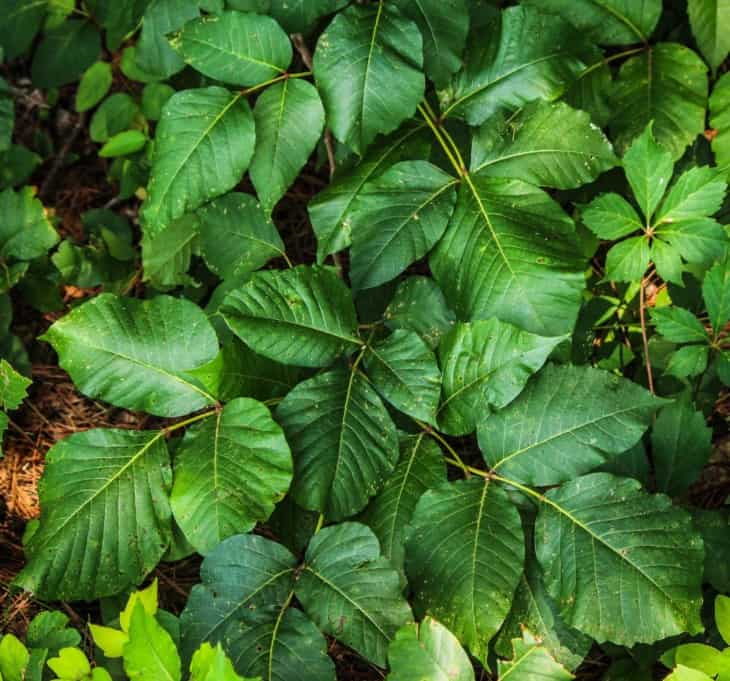
Poison Ivy is a toxic plant that contains an oleoresin known as urushiol. Skin contact with this plant can cause dermatitis, i.e., skin rash, itchiness, inflammation, and oozing blisters. Poison Ivy is an eastern North American native with variable growth. It is recognized by its hairy, serrated foliage that turns red, yellow, or orange in fall. It also has green-yellow, inconspicuous blooms and greenish drupes. You can grow this plant as a climbing vine or a low shrub.
2. Poison Oak (Toxicodendron diversilobum)
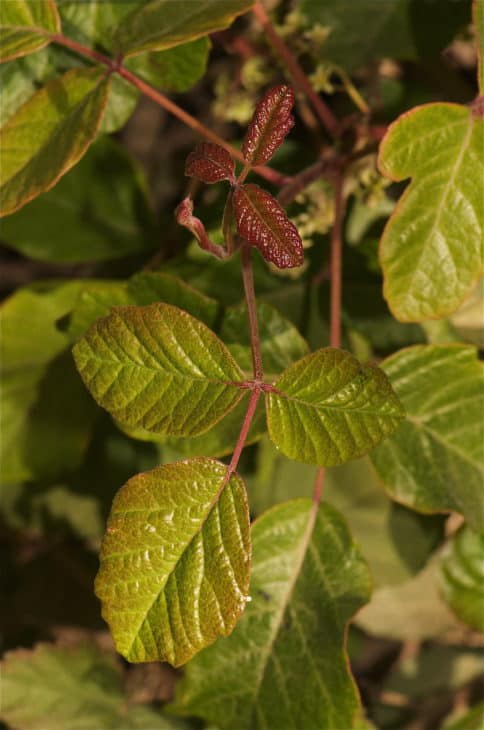
Poison Oak contains a potent allergen called urushiol. Direct contact with its bruised or broken leaves can cause dermatitis, i.e., itchy, swollen, and inflamed skin. This plant is native to western North America. It grows as a low shrub or upright, trailing vine depending on its sunlight exposure. Poison Oak grows oak leaf-type, lobed, green foliage that turns orange-brown or red in fall.
3. Poison Sumac (Toxicodendron vernix)
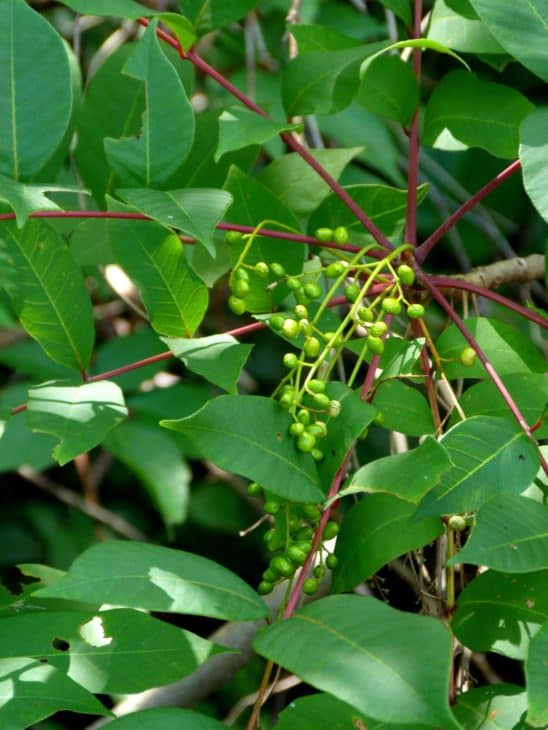
Poison Sumac grows as a woody shrub or tall tree that swamps and hardwood forests. This North American native is recognized by its v-shaped, velvety, elongate, smooth-tipped leaves and reddish stems. It thrives alongside rivers, streams, and ponds. Poison Sumac contains a highly allergenic oily substance known as urushiol. Skin contact can cause irritation, rash, swelling, itchiness, and blisters. Poison Sumac has spherical, grey-white fruits and inconspicuous, green-yellow blooms.
4. Longleaf Milkweed (Asclepias longifolia)
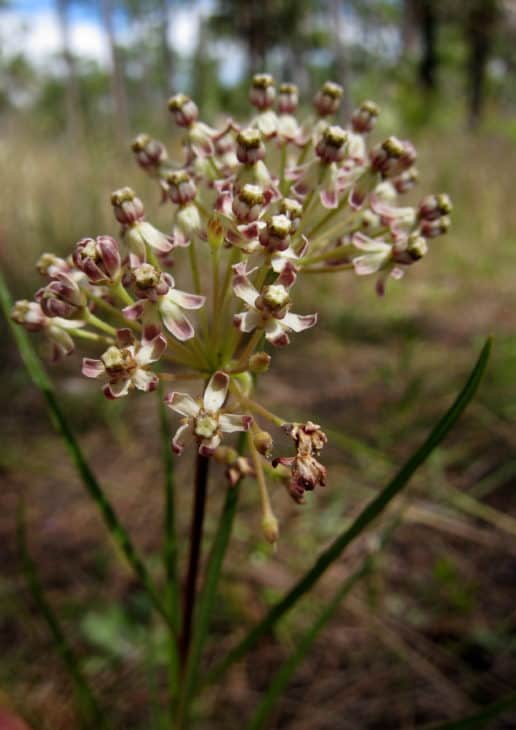
Longleaf Milkweed is an herbaceous perennial that grows in flat woods and prairies. This deciduous plant has slender, unbranched stems that grow several sessile, linear, lanceolate leaves. It also grows terminal umbels of greenish-white blooms tinged with purple. The blooms give way to erect seeds. All parts of Longleaf Milkweed are poisonous when ingested in large quantities. It can cause diarrhea, nausea, and other health troubles. Skin contact can cause irritation.
5. Belladonna Lily (Amaryllis belladonna)
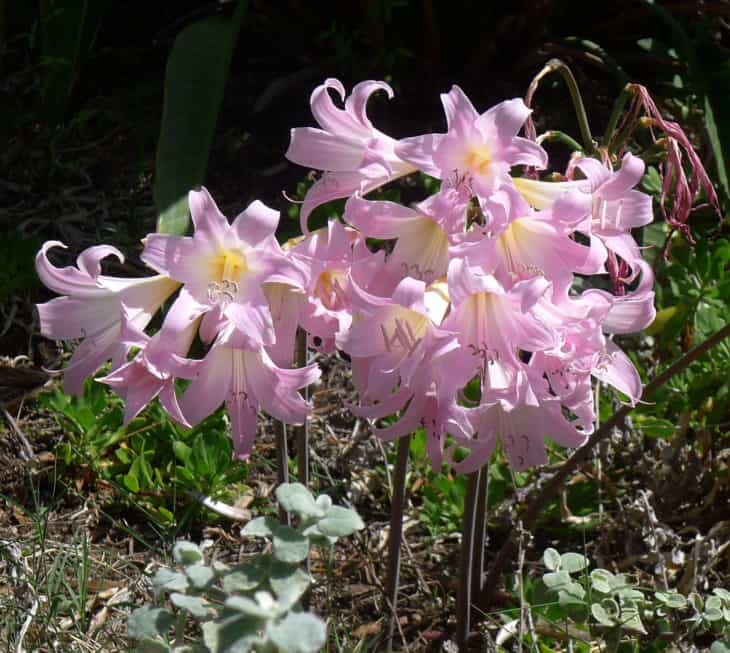
Belladonna Lily is a flowering bulb native to Africa. It grows showy clusters of fragrant pink or burgundy blossoms on its naked, green, and lavender-hued stems. The blooms are followed by leathery, deciduous, strap-like, dull green leaves. All parts of this plant contain poisonous alkaloids that can cause depression, abdominal pain, hypersalivation, vomiting, tremors, and anorexia in animals. The poison doesn’t affect humans severely.
6. Caladium (Caladium x hortulanum)
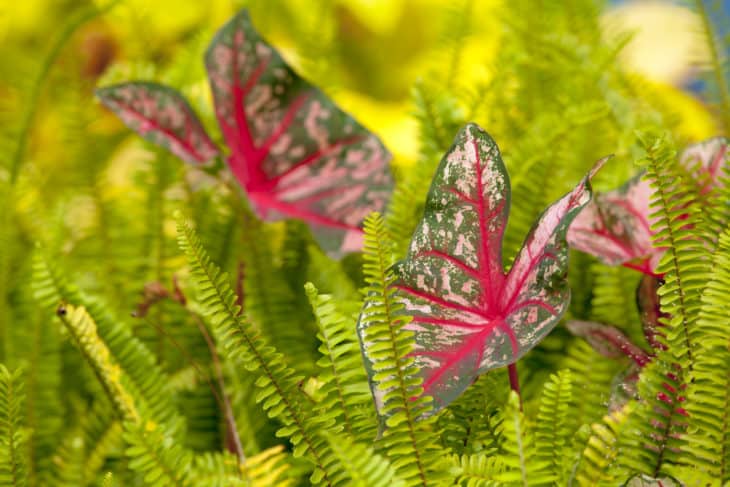
Caladium is an herbaceous tuberous native to tropical forests in South and Central America. Also known as Elephant Year and Heart of Jesus, this non-hardy ornamental can be planted indoors and outdoors. It features attractive leave shaped like a heart or an arrow. The foliage comes in variable hues. Caladium contains oxalate crystals, which is poisonous. Accidental ingestion can cause swelling of the mouth and throat, severe gastric irritation, and excessive salivation. Skin contact with Caladium sap can result in burning and severe itching.
7. Dumb Canes (Dieffenbachia)
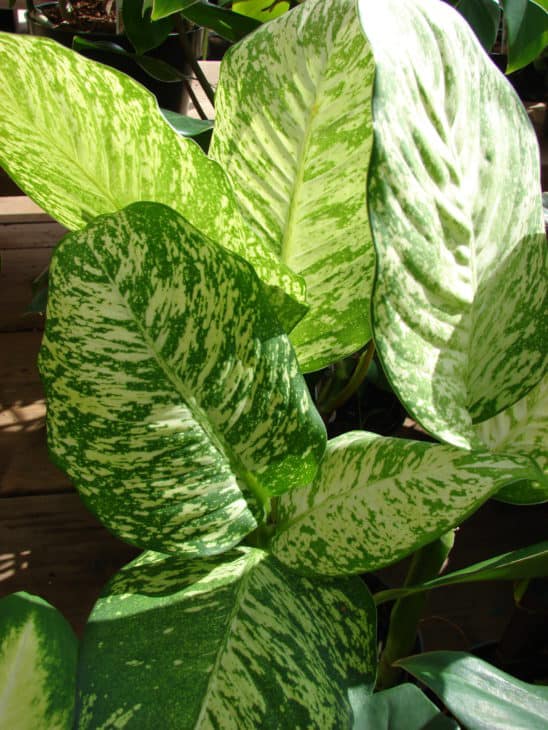
Dumb Canes are poisonous houseplants with variegated leaves that contain cream and yellow markings. These plants contain an acrid sap that causes excessive drooling, vomiting, and numbness of the throat and vocal cords. Skin contact with the sap can result in irritation. The potent sap can also damage the cornea. Dumb Cane grows green stems that are covered with oblong, large leaves with outer edge bands. It also grows inconspicuous green blossoms and berry-like fruits.
8. English Ivy (Hedera helix)
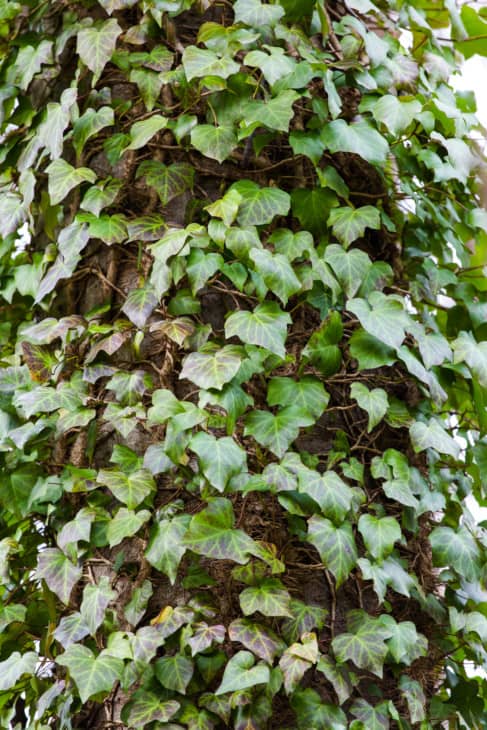
Also known as Sweetheart Ivy, English Ivy is an evergreen vine widespread in urban and distributed forests. This high-climbing vine features broad, green, white, or variegated, glossy, simple, alternate ovate leaves. It has a round green bark and grows green or gold, insignificant blooms. The flowers give way to conspicuous clusters of blue-black berry-type drupes. All parts of this plant are poisonous and can cause contact dermatitis. Ingesting them can cause burning sensations in the throat, stupor, delirium, convulsions, fever, and more.
9. Philodendron (Philodendron)
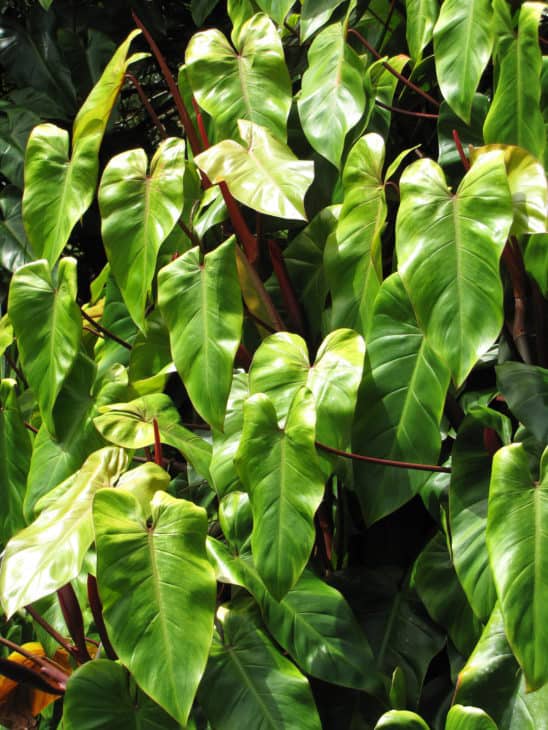
Philodendron is a genus of 450 species of trailing tropical American herbs with stout stems. They are all poisonous plants, and accidentally ingesting them can result in diarrhea, vomiting, burning, and swelling of the throat, tongue, and lips. Many Philodendrons start off as vines and develop into epiphytes. They feature leaves born on long petioles and white, red, or yellow-colored, unisex blooms that give way to orange-red fruits.
10. Sago Palm (Cycas revoluta)
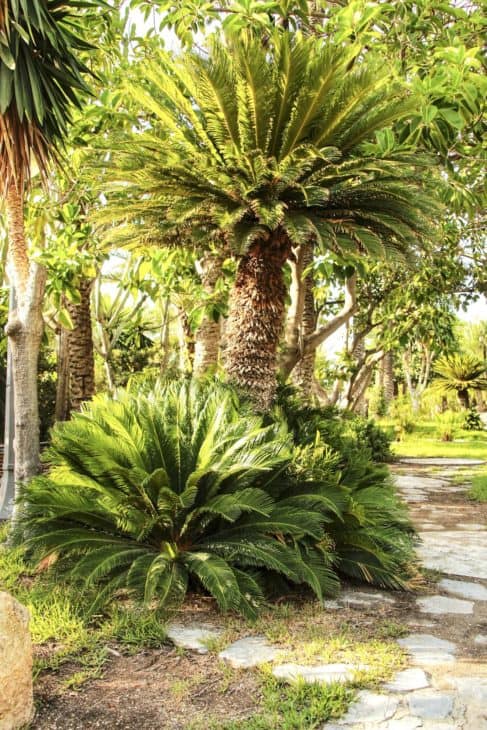
Sago Palm is a non-flowering Japanese and southern Chinese native. This dioecious plant produces nuts but does not flower. It features compound, large, dark green leaves that are considered palm leaves. They develop in a whorl on top of the trunk. This plant contains cytosine, a fast-acting liver toxin. Ingesting Sago Palm can cause diarrhea, loss of appetite, excessive drooling, vomiting, and eventual liver failure.
11. Azaleas (Rhododendron)
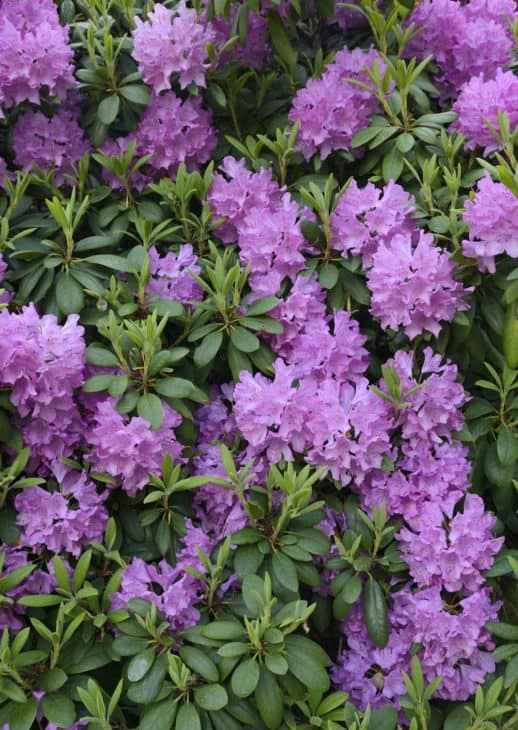
Azaleas are deciduous plants grown as ornamentals worldwide due to their attractive flowers. Native to Europe, North America, and Asia, Azalea bushes contain toxins called grayanotoxins, which make them poisonous. Consuming this plant will result in excessive salivation and a burning sensation in the mouth. Azalea bushes bear funnel-shaped, scented blooms with five projecting stamens and two distinct lips.
12. Hortensia (Hydrangea)
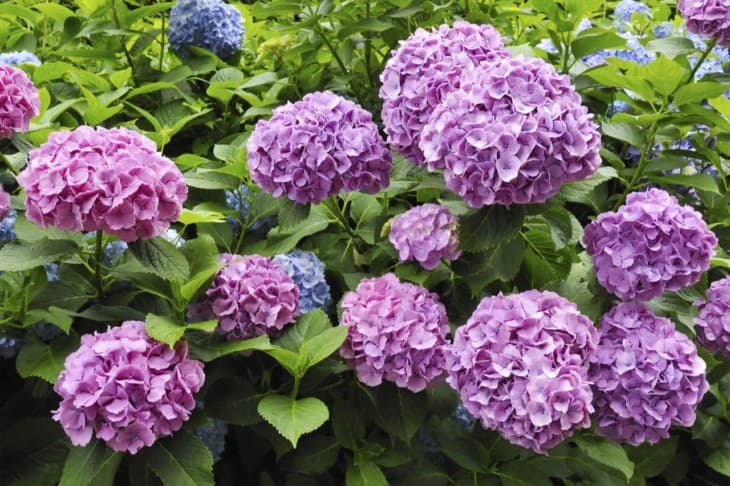
Hortensia, also known as Hortensya, is a popularly grown, rapidly-growing shrub that is poisonous to livestock and humans. It bears striking clusters of brightly-colored blooms that grow in clear blue, frosty white, red, lavender, and vibrant pink colors. All parts of this plant are poisonous as they contain cyanogenic glycoside. Ingesting it will result in nausea, diarrhea, and vomiting. Skin contact will cause dermatitis.
13. Daffodil (Narcissus)
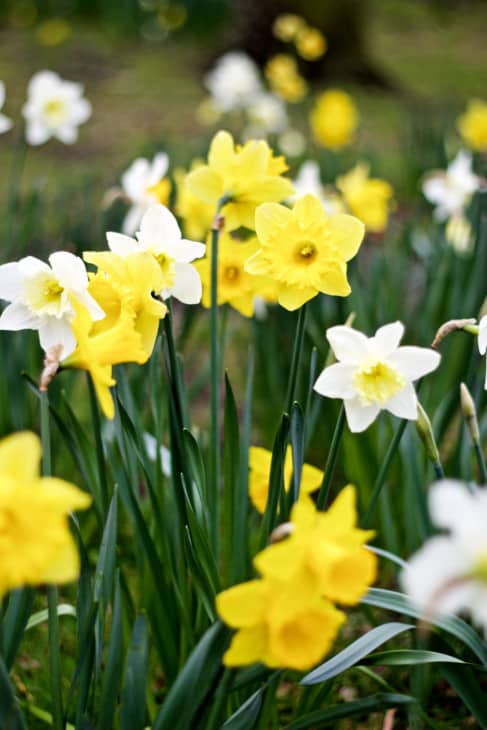
Daffodils are toxic perennial herbaceous plants native to Northern Europe. When consumed in large quantities, they can cause salivation, vomiting, diarrhea, nausea, convulsions, and trembling. Skin contact can result in dermatitis. Consuming the bulbs can result in low BP and cardiac arrhythmias. Daffodils or Tazettas bear showy, pink, white, orange, gold, or variegated scented blooms that are star-like or trumpet-shaped. They also have simple, deciduous, green, strap-shaped, waxy foliage.
14. Tulips (Tulipa)
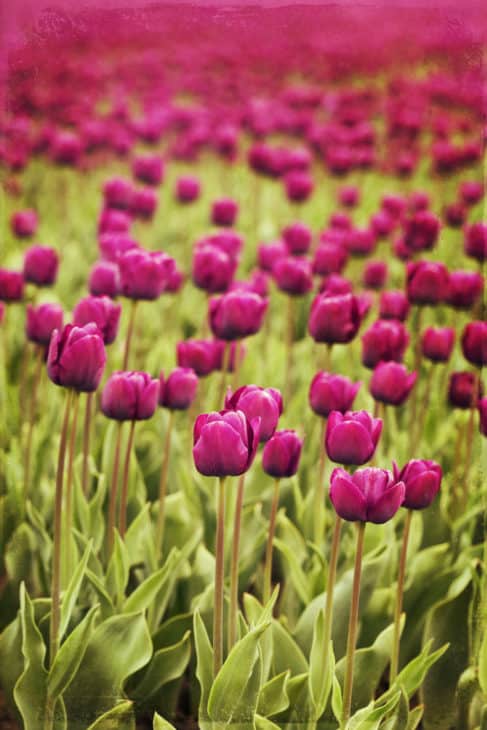
Tulips are bulbous, perennial, herbaceous plants with more than 3500 listed species organized into 15 divisions based on origin and flower shape. They grow racemes of showy, star or cup-shaped, 6-petaled, erect flowers that can be pink, orange, gold, cream, lavender, or variegated. Tulips have blue-green, waxy, alternate, linear, or ovate leaves. The roots, flowers, and leaves of this plant are poisonous, and ingestion can cause salivation, diarrhea, stomach pain, sweating, vomiting, and depression. Skin contact can cause redness, cracks, tingling, and blisters.
15. Elephant’s Ear (Alocasia calidora)
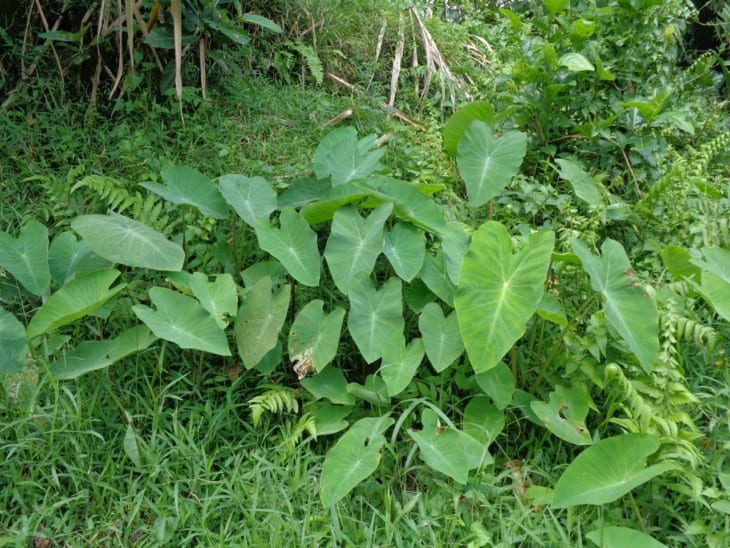
Elephant Ear is an upright, broadleaf, evergreen cultivar with large, striking, tropical-type, arrow-shaped, ribbed foliage. This plant grows in a vase shape and has spadix blooms. It is resistant to heat and humidity. Elephant’s Ear has poisonous leaves that contain insoluble calcium oxalates. Ingesting this plant can result in excessive drooling, pain, and swelling of the lips, mouth, and tongue, vomiting, and difficulty swelling.
16. Lantana (Lantana camara)
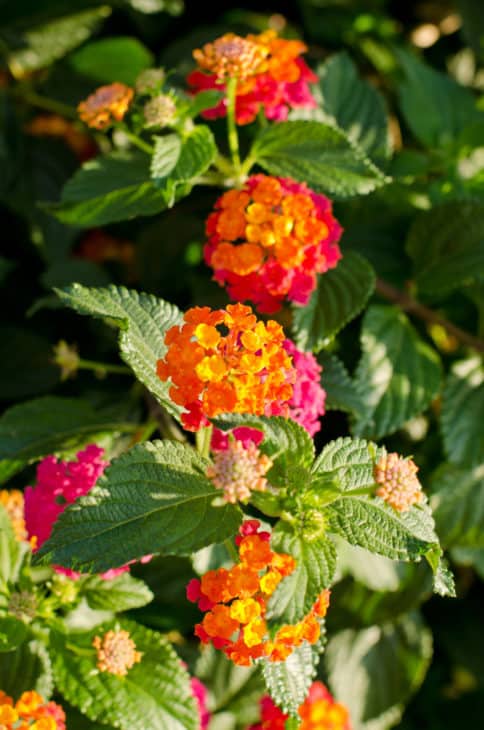
Lantana is a tropical American weed that features rough, simple, scented, ova-shaped foliage that can cause skin irritation. It also produces clusters of yellow, orange, pink, and white blooms and poisonous berries. The dark blue to blackish berries of the Lantana plant are highly toxic and can cause deaths in livestock. This plant contains triterpene acids lantadene A and B, which affect livestock gallbladder and liver.
17. Baneberry (Actaea rubra)
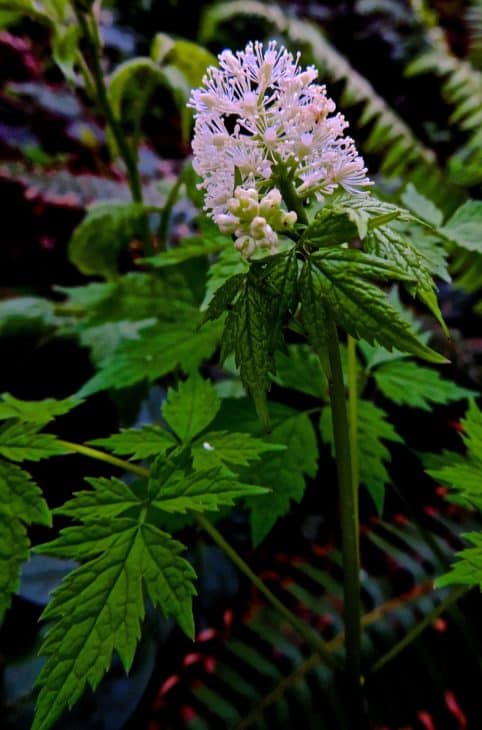
Baneberry is a bushy plant with highly divided, large leaves and round, thick, short clusters of tiny white blooms that grow on stem ends. The small, branched ends of this perennial bear two-three complex leaves that are thrice divided with saw-toothed leaflets. The plant bears attractive red berries that are known to be highly poisonous. When ingested, the berries can cause salivation, diarrhea, headache, dizziness, hallucinations, severe stomach cramps, and affect the nervous system.
18. Bittersweet (Celastrus orbiculatus)
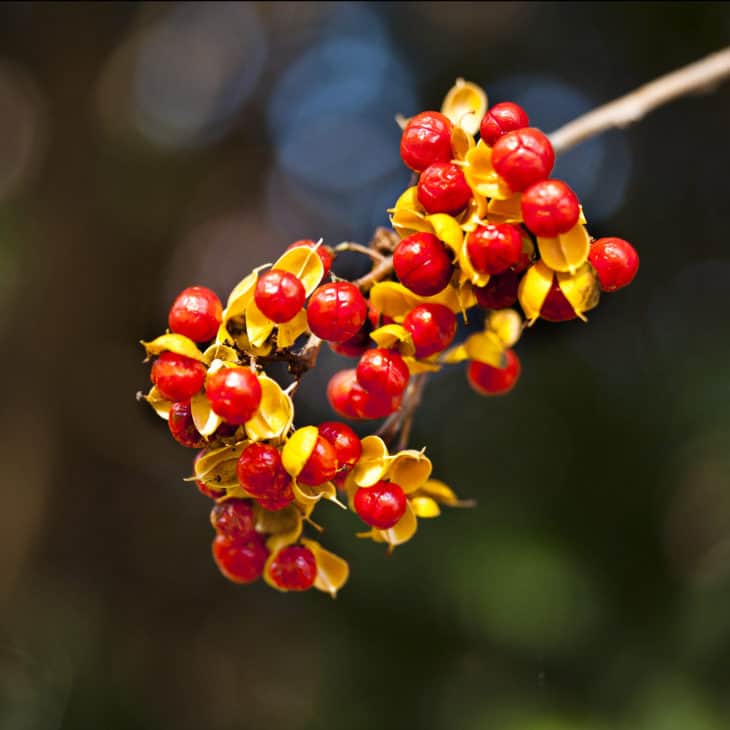
Native to Eastern Asia, Bittersweet is a deciduous, invasive woody vine that grows along roadsides, forest edges, and meadows. It features glossy, green, simple, alternate, ovate leaves with yellow fall color. Bittersweet grows insignificant, green star-shaped blooms that give way to clusters of red or gold, showy capsules. The berries of this plant can be poisonous in large quantities. Ingesting them can result in vomiting and gastrointestinal disturbances.
19. Black Snakeroot (Actaea racemosa)
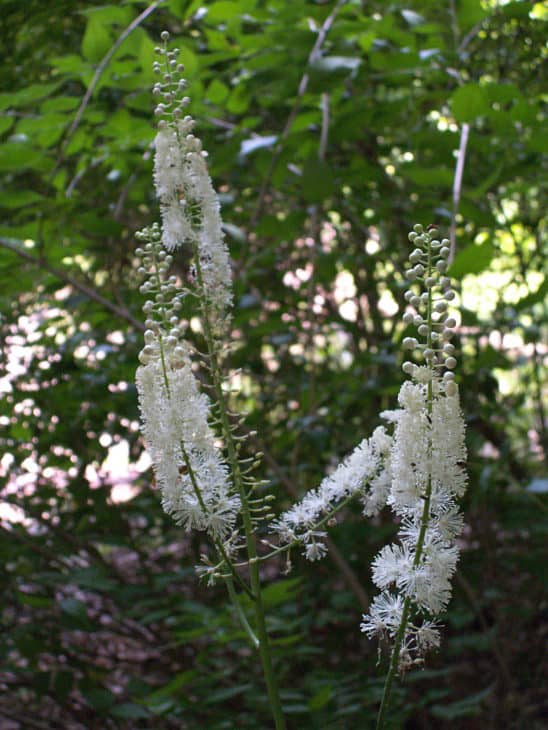
Black Snakeroot or Black Cohosh is an upright, perennial, rhizomatous plant native to eastern North America. It grows in rich, moisture-retentive woodlands and features attractive, deciduous, compound, obovate, serrate, green leaves on purple or green, smooth stems. Black Snakeroot develops tight clusters of white, showy, star-shaped, fluffy-looking blooms with a medicinal odor. Large doses of this plant can cause hypotension, headaches, gastrointestinal disturbances, and more.
20. Caper Spurge (Euphorbia lathyris)
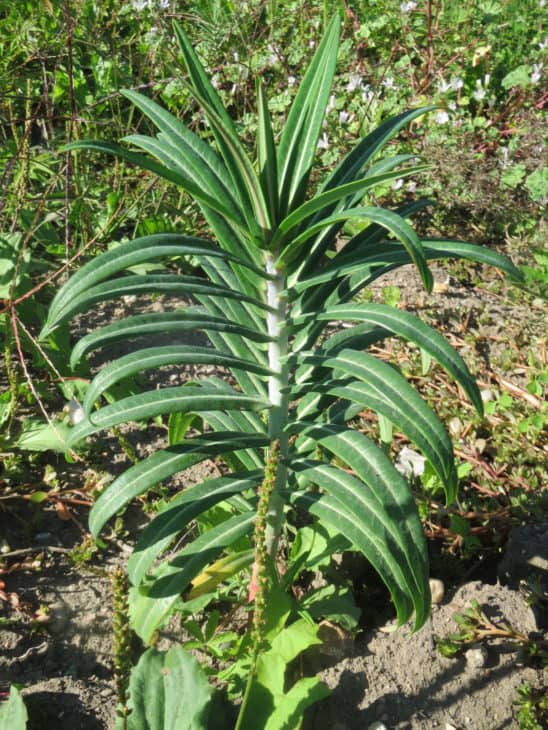
Caper Spurge is an annual or biennial herb that grows around buildings and in waste regions. This self-seeding plant grows green or gold-yellow, spring, cup-shaped blooms that give way to the green, silver, or brown capsules. It also features waxy, alternate, lanceolate, blue-green leaves that grow on straight, fleshy, blue-green stems. All parts of this plant are highly poisonous, and ingesting them can cause diarrhea, vomiting, nausea, and death. Skin contact can result in swelling, blisters, and redness.
21. False Hellebore (Veratrum)
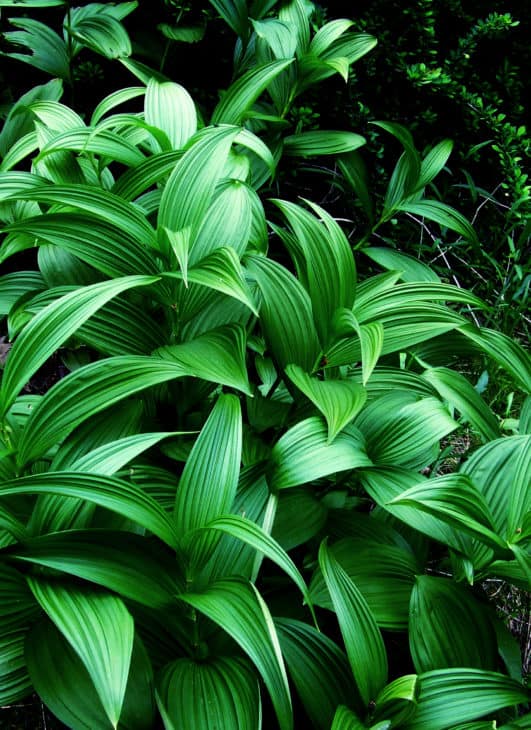
False Hellebores are poisonous perennial plants native to Central and Southern Europe. These plants are known as Cow Cabbage. They grow single-branched stalks, long leaves, and clusters of cream-hued flowers that give way to black seed pods. Every part of a Hellebore is poisonous. However, its roots are ten times more poisonous than its other parts. This plant contains steroidal alkaloids, and ingestion can cause convulsions, coma, frothing at the mouth, vomiting, and irregular gait.
22. Japanese Yew (Taxus cuspidata)
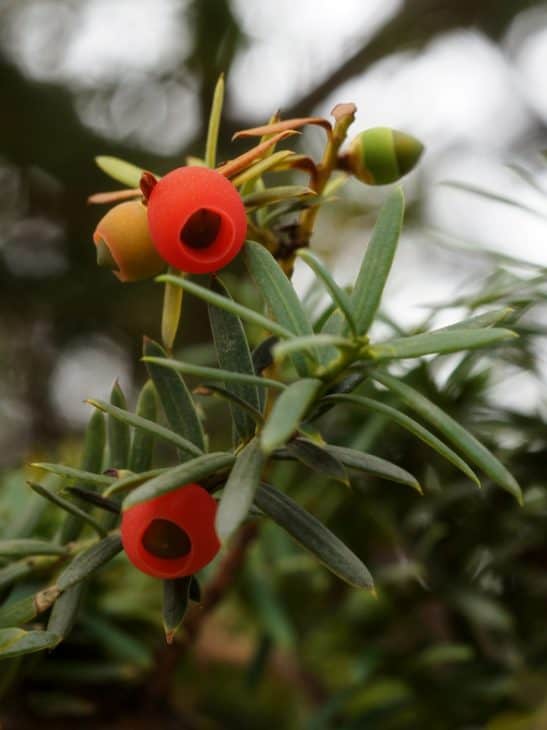
As the name suggests, Japanese Yew is a native Japanese ornamental, evergreen, herbaceous plant cultivated freely in the Northern Hemisphere. Japanese Yew is a fast-growing, hardy plant with leaves that feature distinct yellowish bands on their bottoms. All parts of Japanese Yew are toxic and contain taxines A and B. Ingesting this plant can result in tremors, difficulty breathing, seizures, and vomiting.
23. February Daphne (Daphne mezereum)
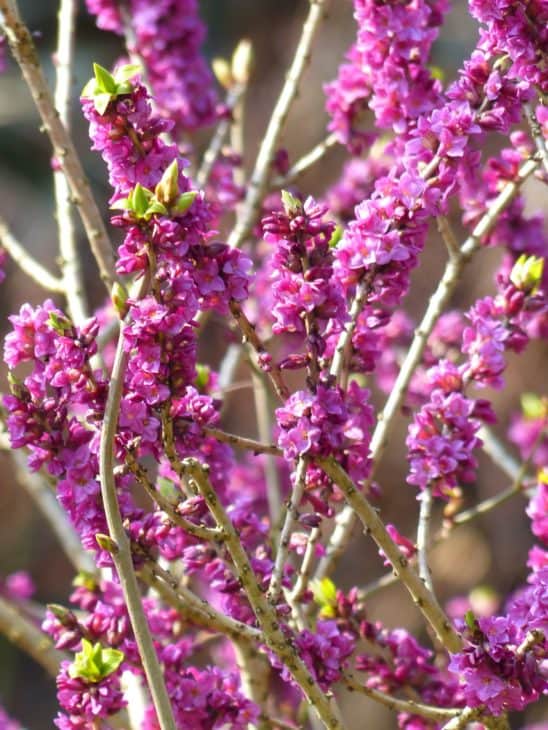
Also known as Spurge Laurel. February Daphne is a small, upright, semi-evergreen, or deciduous shrub native to Iran, Turkey, and some parts of Europe. It’s named February Daphne since it flowers in late winter. It grows dark green, whorled, simple, obovate-lanceolate, shiny leaves.
February Daphne produces pink, white, lavender, or purple blooms that are showy and fragrant and grow in small clusters. The blooms give way to gold, green, and red drupes. February Daphne is a severely toxic plant, and ingestion can cause swelling of the tongue, nausea, vomiting, weakness, coma, bloody diarrhea, skin blisters, and death.
24. Lily of the Valley (Convallaria majalis)
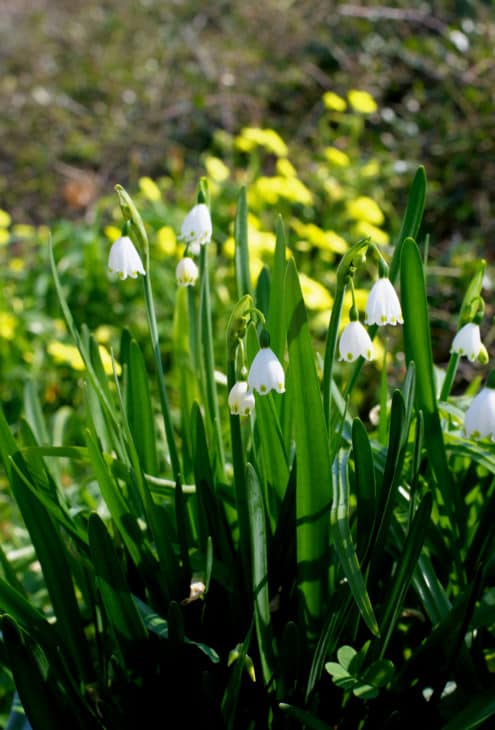
Lily of the Valley is a fragrant, perennial, herbaceous plant native to Eurasia and eastern North America. This plant is cultivated in covered gardens in temperate regions worldwide. Lily of the Valley forms a dense cover of glossy leaves and grows one-sided clusters of bell-shaped, nodding, white blooms. The flowers give way to red, berry-like fruits. This plant has cardiac glycosides, and ingesting it can cause several types of cardiac arrhythmias, including bradycardia and rapid, thread pulse. It can also lead to death.
25. Wolf’s Bane/Monkshood (Aconitum)
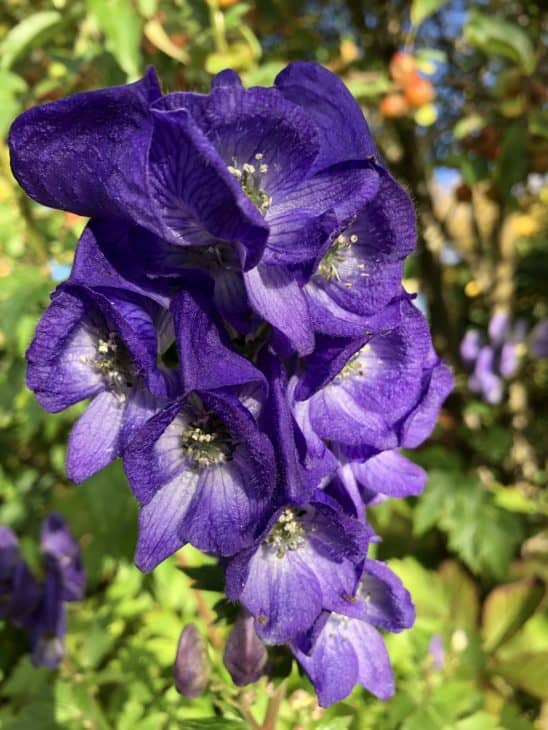
Monkshood is a genus of more than 200 striking perennials, herbaceous plants that thrive in partial shade and rich soils in the North Temperate Zone. All Wolf’s Bane plants are incredibly poisonous, with thick, tuberous roots, leaves with thick lobes, and spike-type clusters of hood-like blooms. The blossoms can be white, purple, blue, or yellow. All parts of a Wolf’s Bane are poisonous, and ingesting them can cause vomiting, nausea, stomach pains, a burning sensation in the mouth, irregular heartbeat, and difficulty in breathing.

